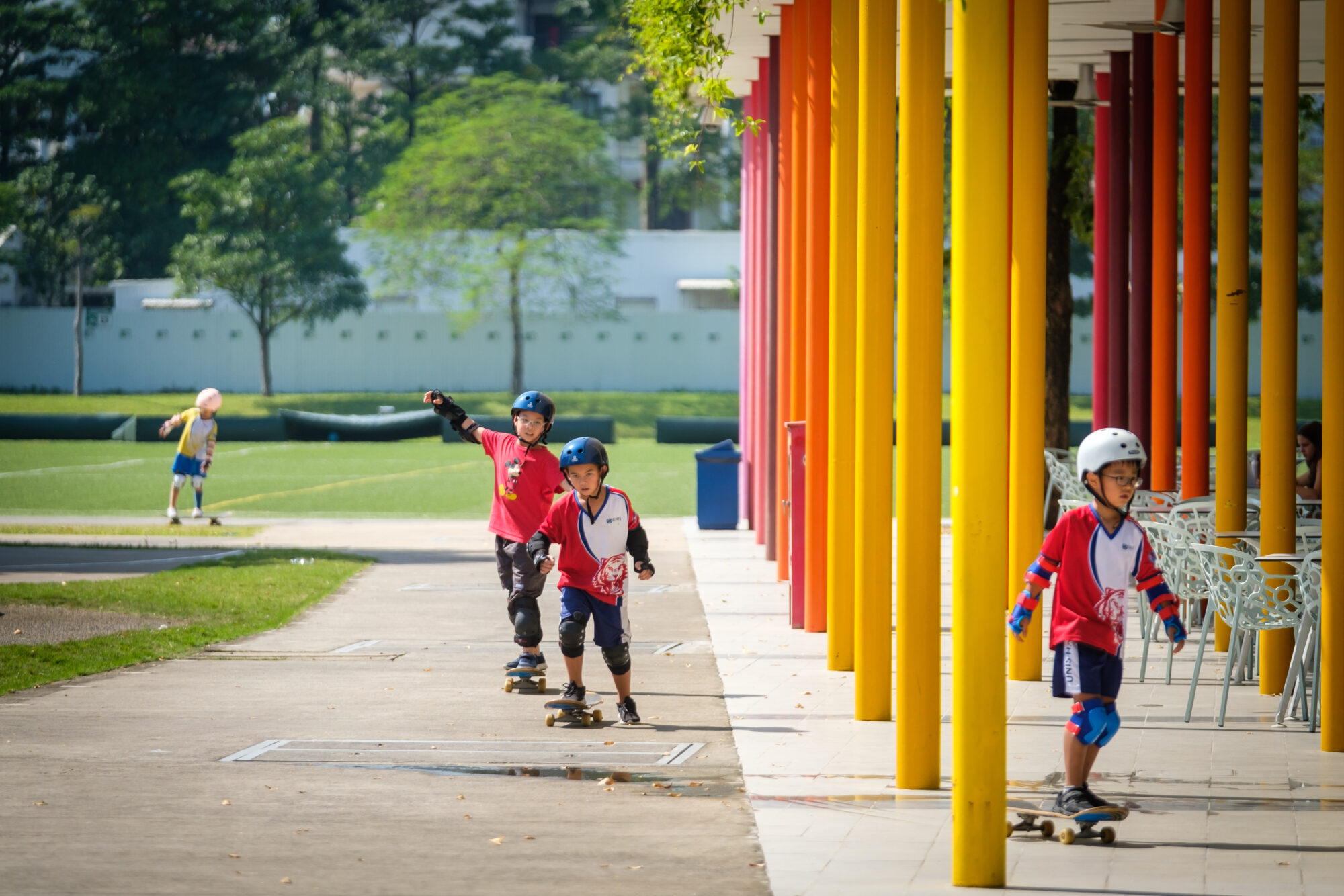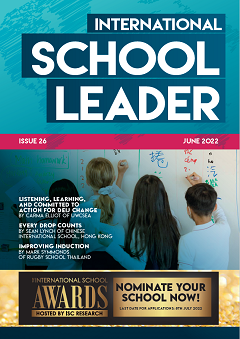By Matthew Magowan
The 2022–2023 school year was a return to a ‘new normal’ – a post-pandemic world which needed a shift in curriculum. As a school we spent 48 weeks in distance learning during an 18-month period with COVID-19 restrictions, which limited movement and prohibited use of play spaces. Following this period, as the elementary school PE team, we inevitably saw the impact on our students’ physical development.
In seeking understanding beyond our context, we turned to research. Current research indicates that a decline in physical activity begins from the age of seven (Farooq et al, 2018; Lounassalo, Salin, Kankaanpaa et al, 2018; and Engel et al, 2018). Additionally, a link between a child’s proficiency with fundamental movement skills and increased physical activity time has been identified (Capio et al, 2015 and Xin and Chen et al, 2020). Therefore, identifying students in the elementary school for support was of the greatest importance.
Research data collected prior to the pandemic (Guthold et al, 2020) evidenced that 85% of children worldwide were classified as inactive, following World Health Organization guidelines, with the highest area in the world for insufficient physical activity being high-income Asia-Pacific for both boys (89%) and girls (95.6%). Nguyen et al (2022, p 55) stated that Vietnam’s “limited recreation facilities were another reason for children’s high prevalence of physical inactivity”. As a PE teacher at a fee-paying international school based in densely populated Hanoi, Vietnam, this research resonated deeply.

Photo: UNIS Hanoi
Fundamental movement skills
As a school we screen every child from the age of three to 11 on their fundamental movement skills (FMS). FMS are the basic movements that children learn in early childhood, they are the foundations for more complex movement patterns and skills that children will learn throughout their lives.
Screening takes place twice a year and this data is used to inform teaching and learning. A total of 543 students were screened, using the 4 Skill Test by Alles in beweging. The screener provides benchmarks for children from two to 12 years, with the screener split into four domains.
- Balance – static equilibrium
- Jumping strength – dynamic balance
- Jumping coordination – coordination between arms and legs
- Bouncing – eye–body coordination
The screening results can be seen in the table below. Data from August 2019 has also been included as a comparison of pre-COVID and post-COVID restrictions.
| Percentage of students two grade levels below in two of the four FMS skill domains | ||
| August 2019 | August 2022 | |
| EY 3 | 0 | 0 |
| EY 4 | 0 | 0 |
| K | 1.6% | 1.6% |
| Grade 1 | 2.6% | 1.3% |
| Grade 2 | 3.9% | 17% |
| Grade 3 | 7.9% | 9.3% |
| Grade 4 | 11% | 20.7% |
| Grade 5 | 9% | 23% |
Photo: Table 1
This data led our team to question how we might be able to support our students and who we might need to collaborate with.
Multi-tiered systems of support (MTSS)
As a school, we started the implementation of MTSS this year. MTSS is a framework which focuses on providing high-quality, data-informed instruction to meet the needs of every student. MTSS provides teachers with three tiers to help organise the curriculum along a continuum ranging from:
- Tier 1 – support for all
- Tier 2 – targeted for some
- Tier 3 – intensive support for few
Following the results of the initial screener in August, the ES PE team identified grade 4 and 5 students as the intervention group for this research project. This was due the high percentage of students in this age range who were testing at two grade levels below in two of the screener domains. Engel et al’s (2018) research, which suggested that participation in children drops after the age of seven if perceived or actual motor competence was below age expectations, also impacted the team’s decision due to the need for an intervention with this age group being more critical.
MTSS within the PE context
Tier 1 is regarded as high-quality core instruction that should take care of the needs of 85–90% of the student population. The PE team plans learning experiences and units collaboratively, ensuring differentiation strategies for a diverse range of learners, and being informed by ongoing assessment data.
Tier 2 instruction became our targeted intervention for students ‘at risk’ or below expectations. The PE team modified the programme of inquiry reducing the number of units taught per year and extending the length of time spent in each unit. This enabled the teaching team more time to provide targeted support for students who needed it within grades 4 and 5. From a combined class of 44 students, our Tier 2 intervention group was around 14 students, which was higher than would normally be the case beyond the parameters of the pandemic.
A modified curriculum also created three two-week blocks where students were placed in targeted intervention groups. Tier 2 and 3 intervention students worked in smaller groups, while students at or above grade-level expectations worked in a group with a larger student-to-teacher ratio receiving continued Tier 1 instruction. This was enabled through a co-teaching model.
The two-week intervention blocks were planned within our year-long Health Related Fitness unit, where students analysed their FMS data and set goals. Teachers conferenced with students to facilitate the goal-making process, and to ensure this was meaningful to the students. The small size of the intervention group enabled the teacher to facilitate interventions focused on the students’ learning targets, whilst aiming to cover the same content (components of fitness) as the Tier 1 group.
Tier 3 provided intensive support for those students most at risk. All parents of students who were identified as Tier 2 and Tier 3 were invited to a parent workshop which explained the screening and provided resources for how they could support their child at home. Tier 3 students were identified from the beginning of year screener, PE teacher observations and/or conversations with our Student Success team. These students received intensive support three times a week for 10 weeks as a pull-out programme led by two PE co-teachers and our athletic trainer. Progress monitoring happened throughout the 10 weeks with a rescreening happening in the final week.
The results
Following the intervention period, all Tier 2 and Tier 3 students were rescreened in January 2023 with the results shown below in Table 2. The results were incredibly positive with only two students in Tier 2 and Tier 3 remaining two grade levels below in two or more areas of the FMS screener. There had been substantial gains for the students in the intervention groups with 77% of the grade 5 and 66% of the grade 4 intervention groups now at grade-level expectation across all four areas of the screener.
| Percentage of students two grade levels below in two of the four FMS skill areas | Tier 2 and Tier 3 students at grade-level expectation across all four FMS domains | ||
| August 2022 | Jan 2023 | Jan 2023 | |
| Grade 5 | 23% | 0% | 77% |
| Grade 4 | 20.7% | 3.2% | 66% |
Photo: Table 2
Conclusion
Following our initial attempt at implementing MTSS within a PE context, it was time to reflect on successes and challenges with the implementation as we look forward to making changes in the following school year:
- MTSS provided a clear framework for identifying students who required support. The data showed that students in the research sample demonstrated a positive response to the intervention following rescreening in January 2023.
- The teacher researcher found it difficult to implement Tier 2 instruction within curriculum time with there being a grey area between core instruction and intervention.
- Time for Tier 2 and Tier 3 interventions was also identified as a challenge area when working within organisational systems (ie, a fixed schedule). Tier 3 interventions took place during closing circle time three times a week. Whilst we used this as a way to encourage a culture of movement for students throughout the week, we found it challenging as it reduced intervention time to 10–15 minutes. In the next academic year, we’ll look at using an after-school activity (60 minutes once a week) and supporting parents more with at-home support. The ES PE team will adapt their programme of inquiry to run year-long health-related fitness units, with the hope this will allow more flexibility to facilitate effective Tier 2 interventions.

Matthew Magowan is an ES PE team lead at UNIS Hanoi, and is dedicated to empowering students to find joy in a diverse range of activities. With a strong passion for research-driven practices, he constantly seeks out evidence-based approaches to enhance teaching and learning experiences. Connect directly with Matthew on LinkedIn.



